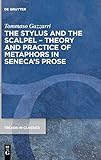The Stylus and the Scalpel : Theory and Practice of Metaphors in Seneca’s Prose / Tommaso Gazzarri.
Material type: TextSeries: Trends in Classics - Supplementary Volumes ; 91Publisher: Berlin ; Boston : De Gruyter, [2020]Copyright date: ©2020Description: 1 online resource (XVII, 266 p.)Content type:
TextSeries: Trends in Classics - Supplementary Volumes ; 91Publisher: Berlin ; Boston : De Gruyter, [2020]Copyright date: ©2020Description: 1 online resource (XVII, 266 p.)Content type: - 9783110673579
- 9783110673777
- 9783110673715
- PA6690 .G39 2020
- online - DeGruyter
- Issued also in print.
| Item type | Current library | Call number | URL | Status | Notes | Barcode | |
|---|---|---|---|---|---|---|---|
 eBook
eBook
|
Biblioteca "Angelicum" Pont. Univ. S.Tommaso d'Aquino Nuvola online | online - DeGruyter (Browse shelf(Opens below)) | Online access | Not for loan (Accesso limitato) | Accesso per gli utenti autorizzati / Access for authorized users | (dgr)9783110673715 |
Dissertation Yale University 2020.
Frontmatter -- Preface -- Contents -- Abbreviations -- Note on Translations -- Introduction -- Part I: Theory: Seneca’s Rhetorical Strategies Between Stoic Tradition and Modern Linguistics -- 1 Metasemes and the Classical Tradition -- 2 Modern Theories on Metaphor and the Stoic System -- 3 Metaphors, Emotions, and Moral Progress -- Part II: Practice: The Text and The Body -- 4 From Metaphor to Metaphors -- 5 Metaphorical Physiology -- 6 A Breathing Body -- Epilogue -- Bibliography -- Index Rerum -- Index Locorum
restricted access online access with authorization star
http://purl.org/coar/access_right/c_16ec
Seneca’s developed metaphors draw on what is known to describe the unknown. They put hard ethical in highly accessible, and often quite entertaining, terms. The present book provides a functional description of Seneca’s dialectical relation between metaphorical language and philosophy. It shows how Stoic philosophy finds a new means of expression in Seneca’s highly elaborated rhetorical discourse, and how this relates to the social and cultural demands of Neronian culture. Metaphors are purposely utilized to work "collectively" rather than by category or type and that, therefore, the analysis of what metaphors do when Seneca chooses to combine them in clusters, demonstrates the existence of a "metanarrative of rhetoric". This approach is fundamentally innovative and has the advantage of gauging the functioning of Senecan style as a whole, rather than focusing on single features of its rhetorical functioning. The main target is to show how philosophical preaching materially contributes to the healing of human soul because it shapes the individual’s cognitive faculty in a way that is physical and not simply figurative. The stylus and the scalpel blend in their functions. This kind of therapy is not just the simulacrum of a more "real" one, it is in itself medical in nature.
Issued also in print.
Mode of access: Internet via World Wide Web.
In English.
Description based on online resource; title from PDF title page (publisher's Web site, viewed 28. Feb 2023)


